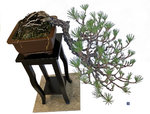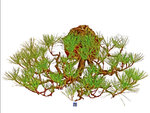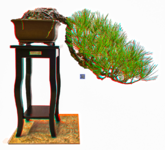GrimLore
Bonsai Nut alumnus... we miss you
Here is how it looks today.
WoW! It also appears to defy gravity! How in the world does it stay on the stand?
Grimmy
Here is how it looks today.
Yes! Much better.I considered the picture above for a long time and concluded that the stand used wasn't the right one. Even though in the past I have not liked very tall stands for cascade bonsai, I felt that this particular stand worked well for my tree. The Ondae is about 3 feet wide.
View attachment 200872

Still a little too long.






This tree, a cork bark Japanese black pine ‘Ondae’, was due for a repot. It had been at least 5 years since the original potting, so early one March morning, I began.Interesting idea, Fred.
There's sort of a circle thing going on around the trunk that tends to focus attention on it.
It makes me want to see more of the trunk, though. But the feeling that less foliage would be better is gone in the view.


